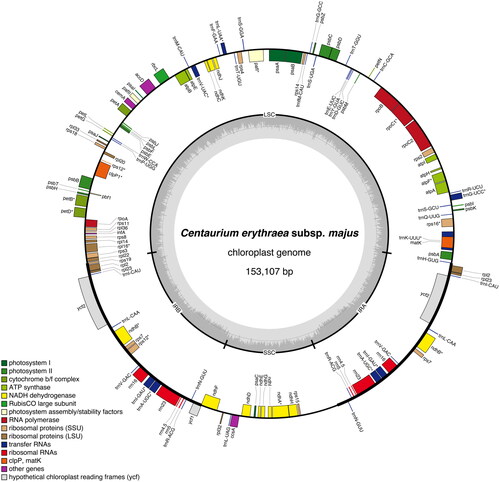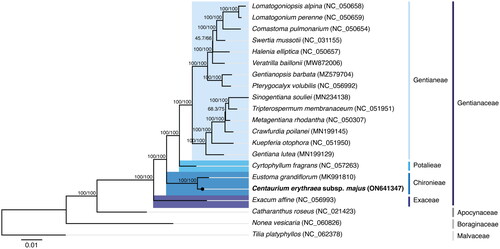Figures & data
Figure 1. Detail of C. erythraea subsp. majus isolate BPTPS121 (BioSample: SAMN28118559) after being dried and before being mounted and conserved at the LISE Herbarium (INIAV, Oeiras, Portugal; Jorge Capelo: [email protected]) under the voucher LISE: 96442 (identified by: Jorge Capelo). This isolate was collected from a wild population in Torres Vedras municipality (Dois Portos) in Portugal (collection date: 15 June 2020; location: 39.06612 N, 9.1788 W).

Figure 2. Graphical map of the complete chloroplast genome of Centaurium erythraea subsp. majus isolate BPTPS121 based on the conversion of annotations openly available in GenBank (accession number: ON641347), color coded based on their functional group, using OrganellarGenomeDRAW (OGDRAW) version 1.3.1 (Greiner et al. Citation2019). Genes inside the circle are transcribed clockwise, genes outside the circle counterclockwise, and intron-containing genes are marked by an asterisk (*). LSC: large single-copy region; SSC: small single-copy region; IRA, IRB: inverted repeats (IR). The dark grey inner ring represents the GC content, while the complementary light grey ring represents the AT content.

Figure 3. Maximum-likelihood tree inferred from the sequences coding for the shared proteome from Centaurium erythraea subsp. majus isolate BPTPS121 and 17 verified and complete chloroplast genomes belonging to the Gentianaceae family available in GenBank (accession date: 26 June 2022). The numbers attached to the branches show the SH-aLRT and the UFBoot2 percent supports (SH-aLRT/UFBoot2). Catharanthus roseus (L.) G.Don (NC_021423; lamiids clade, Apocynaceae family), Nonea vesicaria (L.) Rchb. (NC_060826; lamiids clade, Boraginales order), and Tilia platyphyllos Scop. (NC_062378; malvids clade, Malvales order) were used as the outgroups.

Data availability statement
The data that support this study is openly available in GenBank of NCBI at https://www.ncbi.nlm.nih.gov under the accession number ON641347. The associated BioProject, BioSample, and SRA numbers are PRJNA848681, SAMN28118559, and ERR10047930, respectively.
